Managing Strategy, Operations and Partnerships
VerifiedAdded on 2023/01/03
|14
|3972
|64
AI Summary
This document discusses the importance of managing strategy, operations, and partnerships in achieving a competitive advantage. It explores Thermax Ltd, an engineering company, and its sustainable solutions in energy and environment. The document covers topics such as competitive advantage, strategic proposals, stakeholder analysis, and the requirements for each stage of analysis. It also highlights the company's focus on portfolio balancing, selective internationalization, and innovation. Additionally, it discusses stakeholder analysis and the role of non-market and market stakeholders. Overall, this document provides insights into managing strategy, operations, and partnerships for business success.
Contribute Materials
Your contribution can guide someone’s learning journey. Share your
documents today.
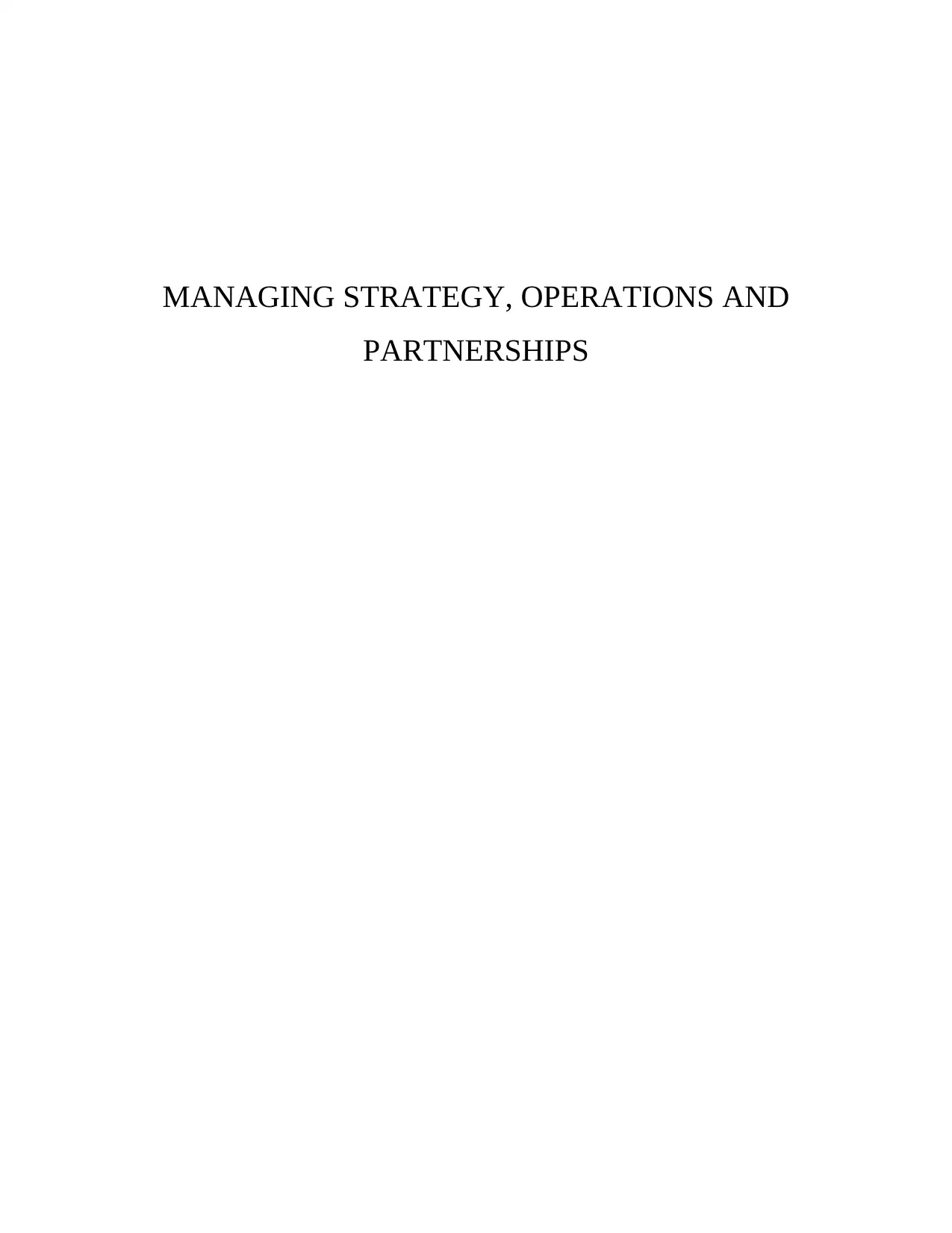
MANAGING STRATEGY, OPERATIONS AND
PARTNERSHIPS
PARTNERSHIPS
Secure Best Marks with AI Grader
Need help grading? Try our AI Grader for instant feedback on your assignments.
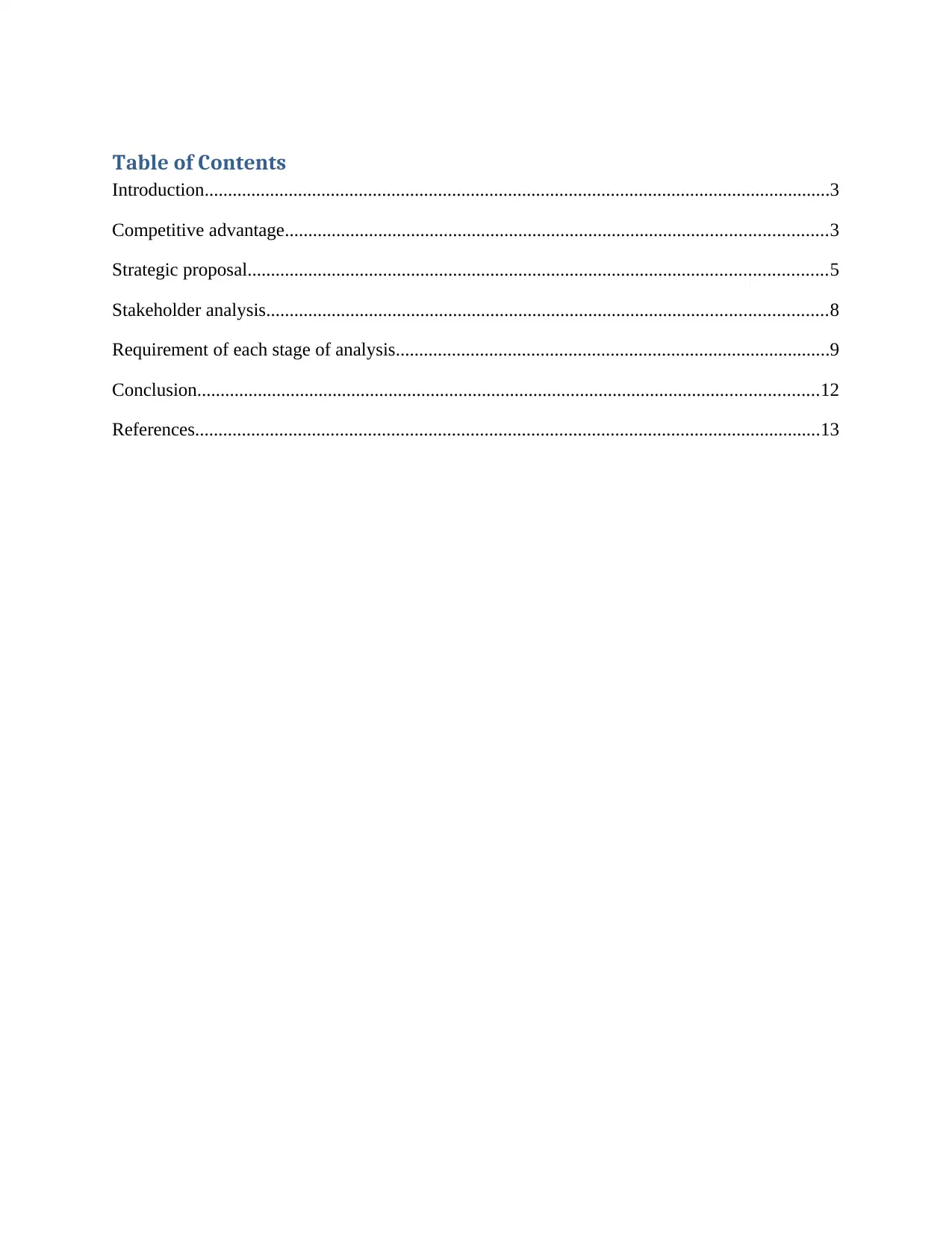
Table of Contents
Introduction......................................................................................................................................3
Competitive advantage....................................................................................................................3
Strategic proposal............................................................................................................................5
Stakeholder analysis........................................................................................................................8
Requirement of each stage of analysis.............................................................................................9
Conclusion.....................................................................................................................................12
References......................................................................................................................................13
Introduction......................................................................................................................................3
Competitive advantage....................................................................................................................3
Strategic proposal............................................................................................................................5
Stakeholder analysis........................................................................................................................8
Requirement of each stage of analysis.............................................................................................9
Conclusion.....................................................................................................................................12
References......................................................................................................................................13
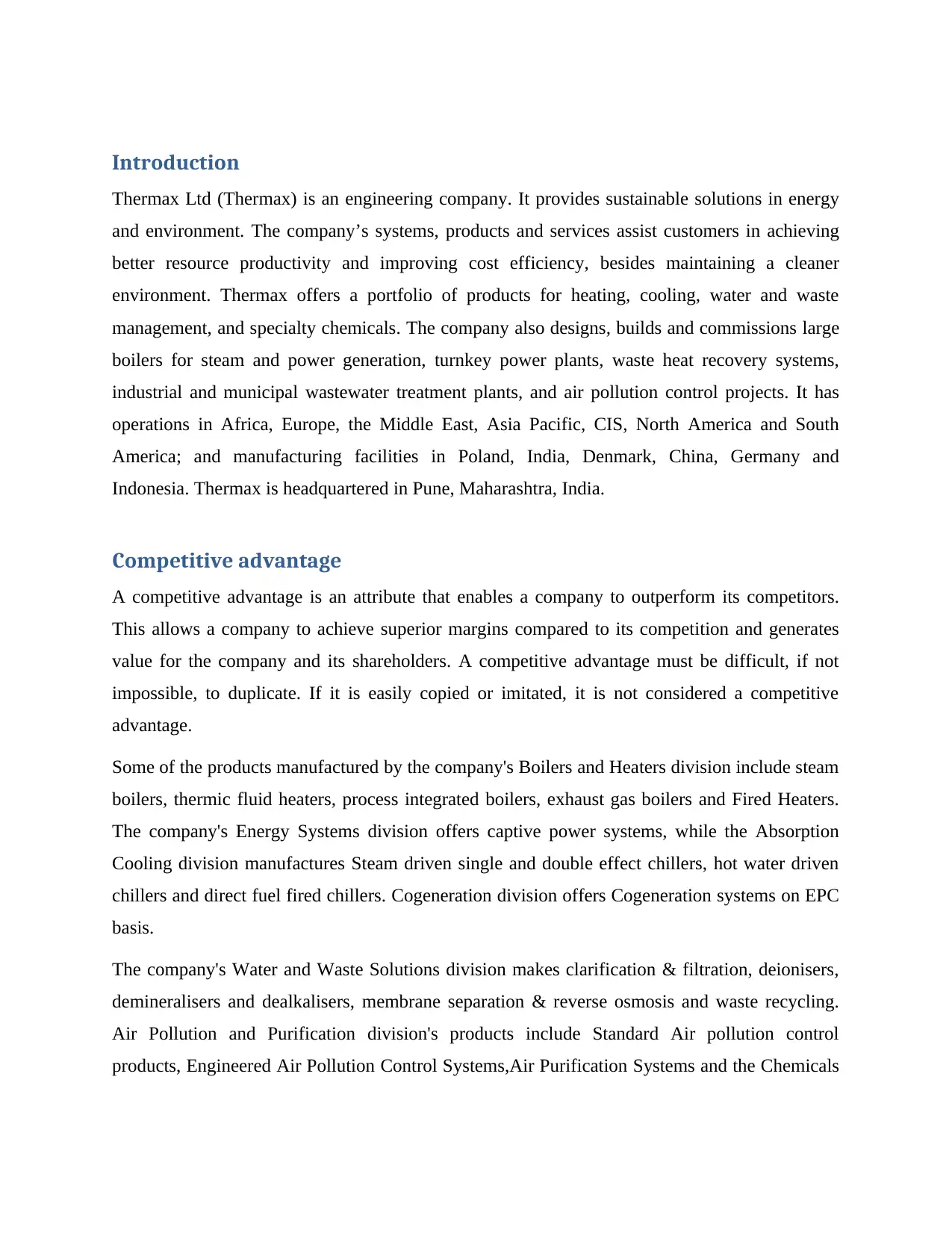
Introduction
Thermax Ltd (Thermax) is an engineering company. It provides sustainable solutions in energy
and environment. The company’s systems, products and services assist customers in achieving
better resource productivity and improving cost efficiency, besides maintaining a cleaner
environment. Thermax offers a portfolio of products for heating, cooling, water and waste
management, and specialty chemicals. The company also designs, builds and commissions large
boilers for steam and power generation, turnkey power plants, waste heat recovery systems,
industrial and municipal wastewater treatment plants, and air pollution control projects. It has
operations in Africa, Europe, the Middle East, Asia Pacific, CIS, North America and South
America; and manufacturing facilities in Poland, India, Denmark, China, Germany and
Indonesia. Thermax is headquartered in Pune, Maharashtra, India.
Competitive advantage
A competitive advantage is an attribute that enables a company to outperform its competitors.
This allows a company to achieve superior margins compared to its competition and generates
value for the company and its shareholders. A competitive advantage must be difficult, if not
impossible, to duplicate. If it is easily copied or imitated, it is not considered a competitive
advantage.
Some of the products manufactured by the company's Boilers and Heaters division include steam
boilers, thermic fluid heaters, process integrated boilers, exhaust gas boilers and Fired Heaters.
The company's Energy Systems division offers captive power systems, while the Absorption
Cooling division manufactures Steam driven single and double effect chillers, hot water driven
chillers and direct fuel fired chillers. Cogeneration division offers Cogeneration systems on EPC
basis.
The company's Water and Waste Solutions division makes clarification & filtration, deionisers,
demineralisers and dealkalisers, membrane separation & reverse osmosis and waste recycling.
Air Pollution and Purification division's products include Standard Air pollution control
products, Engineered Air Pollution Control Systems,Air Purification Systems and the Chemicals
Thermax Ltd (Thermax) is an engineering company. It provides sustainable solutions in energy
and environment. The company’s systems, products and services assist customers in achieving
better resource productivity and improving cost efficiency, besides maintaining a cleaner
environment. Thermax offers a portfolio of products for heating, cooling, water and waste
management, and specialty chemicals. The company also designs, builds and commissions large
boilers for steam and power generation, turnkey power plants, waste heat recovery systems,
industrial and municipal wastewater treatment plants, and air pollution control projects. It has
operations in Africa, Europe, the Middle East, Asia Pacific, CIS, North America and South
America; and manufacturing facilities in Poland, India, Denmark, China, Germany and
Indonesia. Thermax is headquartered in Pune, Maharashtra, India.
Competitive advantage
A competitive advantage is an attribute that enables a company to outperform its competitors.
This allows a company to achieve superior margins compared to its competition and generates
value for the company and its shareholders. A competitive advantage must be difficult, if not
impossible, to duplicate. If it is easily copied or imitated, it is not considered a competitive
advantage.
Some of the products manufactured by the company's Boilers and Heaters division include steam
boilers, thermic fluid heaters, process integrated boilers, exhaust gas boilers and Fired Heaters.
The company's Energy Systems division offers captive power systems, while the Absorption
Cooling division manufactures Steam driven single and double effect chillers, hot water driven
chillers and direct fuel fired chillers. Cogeneration division offers Cogeneration systems on EPC
basis.
The company's Water and Waste Solutions division makes clarification & filtration, deionisers,
demineralisers and dealkalisers, membrane separation & reverse osmosis and waste recycling.
Air Pollution and Purification division's products include Standard Air pollution control
products, Engineered Air Pollution Control Systems,Air Purification Systems and the Chemicals
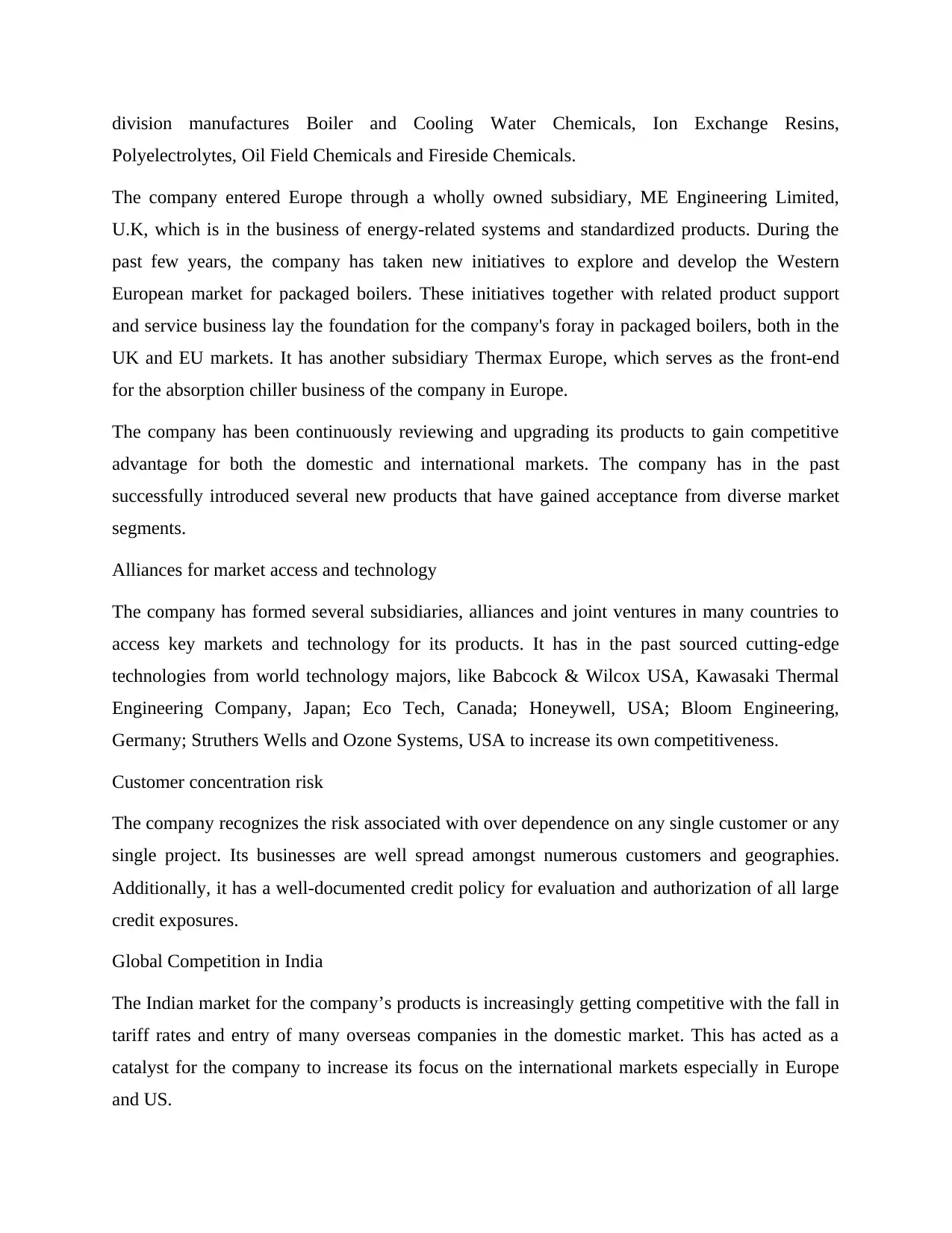
division manufactures Boiler and Cooling Water Chemicals, Ion Exchange Resins,
Polyelectrolytes, Oil Field Chemicals and Fireside Chemicals.
The company entered Europe through a wholly owned subsidiary, ME Engineering Limited,
U.K, which is in the business of energy-related systems and standardized products. During the
past few years, the company has taken new initiatives to explore and develop the Western
European market for packaged boilers. These initiatives together with related product support
and service business lay the foundation for the company's foray in packaged boilers, both in the
UK and EU markets. It has another subsidiary Thermax Europe, which serves as the front-end
for the absorption chiller business of the company in Europe.
The company has been continuously reviewing and upgrading its products to gain competitive
advantage for both the domestic and international markets. The company has in the past
successfully introduced several new products that have gained acceptance from diverse market
segments.
Alliances for market access and technology
The company has formed several subsidiaries, alliances and joint ventures in many countries to
access key markets and technology for its products. It has in the past sourced cutting-edge
technologies from world technology majors, like Babcock & Wilcox USA, Kawasaki Thermal
Engineering Company, Japan; Eco Tech, Canada; Honeywell, USA; Bloom Engineering,
Germany; Struthers Wells and Ozone Systems, USA to increase its own competitiveness.
Customer concentration risk
The company recognizes the risk associated with over dependence on any single customer or any
single project. Its businesses are well spread amongst numerous customers and geographies.
Additionally, it has a well-documented credit policy for evaluation and authorization of all large
credit exposures.
Global Competition in India
The Indian market for the company’s products is increasingly getting competitive with the fall in
tariff rates and entry of many overseas companies in the domestic market. This has acted as a
catalyst for the company to increase its focus on the international markets especially in Europe
and US.
Polyelectrolytes, Oil Field Chemicals and Fireside Chemicals.
The company entered Europe through a wholly owned subsidiary, ME Engineering Limited,
U.K, which is in the business of energy-related systems and standardized products. During the
past few years, the company has taken new initiatives to explore and develop the Western
European market for packaged boilers. These initiatives together with related product support
and service business lay the foundation for the company's foray in packaged boilers, both in the
UK and EU markets. It has another subsidiary Thermax Europe, which serves as the front-end
for the absorption chiller business of the company in Europe.
The company has been continuously reviewing and upgrading its products to gain competitive
advantage for both the domestic and international markets. The company has in the past
successfully introduced several new products that have gained acceptance from diverse market
segments.
Alliances for market access and technology
The company has formed several subsidiaries, alliances and joint ventures in many countries to
access key markets and technology for its products. It has in the past sourced cutting-edge
technologies from world technology majors, like Babcock & Wilcox USA, Kawasaki Thermal
Engineering Company, Japan; Eco Tech, Canada; Honeywell, USA; Bloom Engineering,
Germany; Struthers Wells and Ozone Systems, USA to increase its own competitiveness.
Customer concentration risk
The company recognizes the risk associated with over dependence on any single customer or any
single project. Its businesses are well spread amongst numerous customers and geographies.
Additionally, it has a well-documented credit policy for evaluation and authorization of all large
credit exposures.
Global Competition in India
The Indian market for the company’s products is increasingly getting competitive with the fall in
tariff rates and entry of many overseas companies in the domestic market. This has acted as a
catalyst for the company to increase its focus on the international markets especially in Europe
and US.
Secure Best Marks with AI Grader
Need help grading? Try our AI Grader for instant feedback on your assignments.
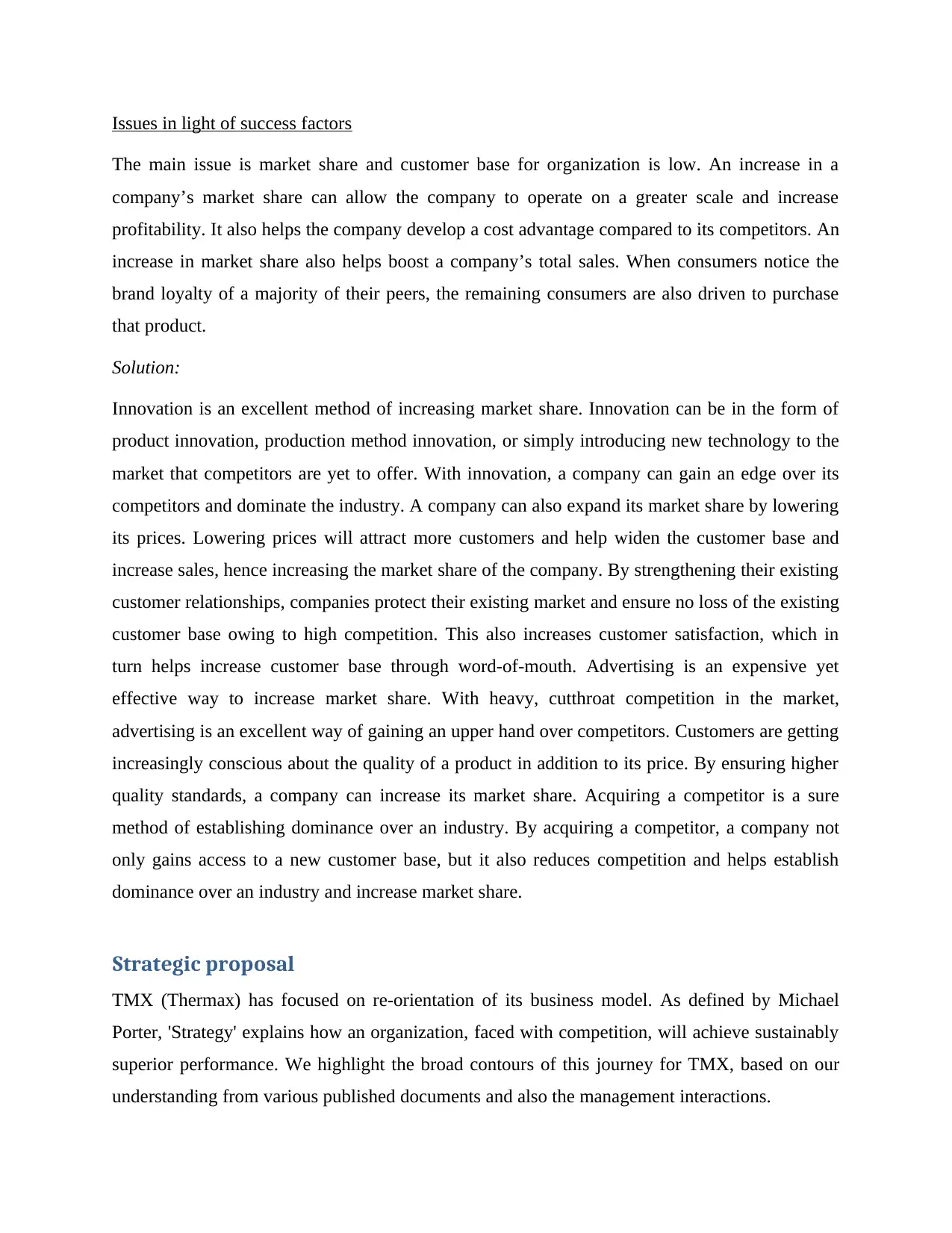
Issues in light of success factors
The main issue is market share and customer base for organization is low. An increase in a
company’s market share can allow the company to operate on a greater scale and increase
profitability. It also helps the company develop a cost advantage compared to its competitors. An
increase in market share also helps boost a company’s total sales. When consumers notice the
brand loyalty of a majority of their peers, the remaining consumers are also driven to purchase
that product.
Solution:
Innovation is an excellent method of increasing market share. Innovation can be in the form of
product innovation, production method innovation, or simply introducing new technology to the
market that competitors are yet to offer. With innovation, a company can gain an edge over its
competitors and dominate the industry. A company can also expand its market share by lowering
its prices. Lowering prices will attract more customers and help widen the customer base and
increase sales, hence increasing the market share of the company. By strengthening their existing
customer relationships, companies protect their existing market and ensure no loss of the existing
customer base owing to high competition. This also increases customer satisfaction, which in
turn helps increase customer base through word-of-mouth. Advertising is an expensive yet
effective way to increase market share. With heavy, cutthroat competition in the market,
advertising is an excellent way of gaining an upper hand over competitors. Customers are getting
increasingly conscious about the quality of a product in addition to its price. By ensuring higher
quality standards, a company can increase its market share. Acquiring a competitor is a sure
method of establishing dominance over an industry. By acquiring a competitor, a company not
only gains access to a new customer base, but it also reduces competition and helps establish
dominance over an industry and increase market share.
Strategic proposal
TMX (Thermax) has focused on re-orientation of its business model. As defined by Michael
Porter, 'Strategy' explains how an organization, faced with competition, will achieve sustainably
superior performance. We highlight the broad contours of this journey for TMX, based on our
understanding from various published documents and also the management interactions.
The main issue is market share and customer base for organization is low. An increase in a
company’s market share can allow the company to operate on a greater scale and increase
profitability. It also helps the company develop a cost advantage compared to its competitors. An
increase in market share also helps boost a company’s total sales. When consumers notice the
brand loyalty of a majority of their peers, the remaining consumers are also driven to purchase
that product.
Solution:
Innovation is an excellent method of increasing market share. Innovation can be in the form of
product innovation, production method innovation, or simply introducing new technology to the
market that competitors are yet to offer. With innovation, a company can gain an edge over its
competitors and dominate the industry. A company can also expand its market share by lowering
its prices. Lowering prices will attract more customers and help widen the customer base and
increase sales, hence increasing the market share of the company. By strengthening their existing
customer relationships, companies protect their existing market and ensure no loss of the existing
customer base owing to high competition. This also increases customer satisfaction, which in
turn helps increase customer base through word-of-mouth. Advertising is an expensive yet
effective way to increase market share. With heavy, cutthroat competition in the market,
advertising is an excellent way of gaining an upper hand over competitors. Customers are getting
increasingly conscious about the quality of a product in addition to its price. By ensuring higher
quality standards, a company can increase its market share. Acquiring a competitor is a sure
method of establishing dominance over an industry. By acquiring a competitor, a company not
only gains access to a new customer base, but it also reduces competition and helps establish
dominance over an industry and increase market share.
Strategic proposal
TMX (Thermax) has focused on re-orientation of its business model. As defined by Michael
Porter, 'Strategy' explains how an organization, faced with competition, will achieve sustainably
superior performance. We highlight the broad contours of this journey for TMX, based on our
understanding from various published documents and also the management interactions.
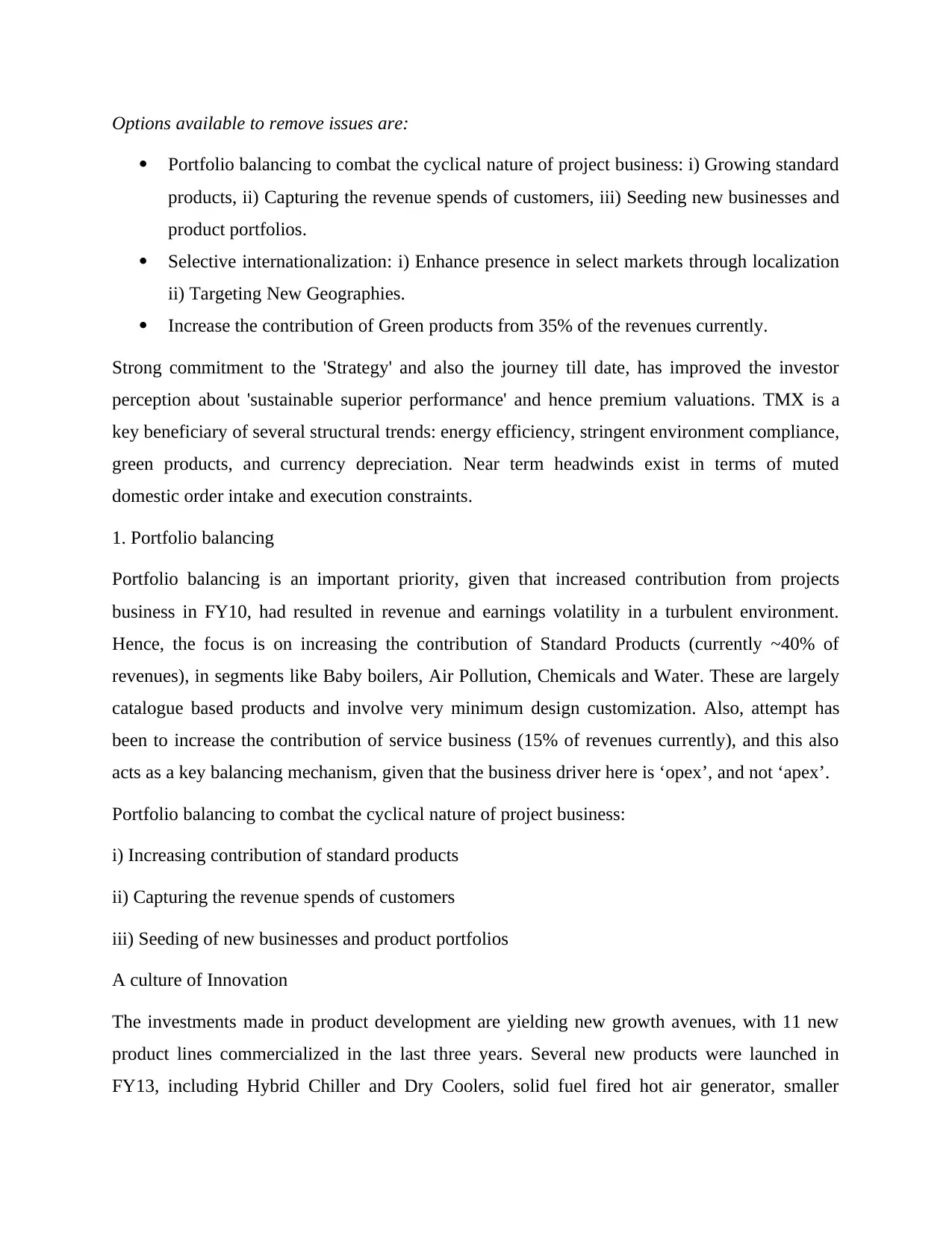
Options available to remove issues are:
Portfolio balancing to combat the cyclical nature of project business: i) Growing standard
products, ii) Capturing the revenue spends of customers, iii) Seeding new businesses and
product portfolios.
Selective internationalization: i) Enhance presence in select markets through localization
ii) Targeting New Geographies.
Increase the contribution of Green products from 35% of the revenues currently.
Strong commitment to the 'Strategy' and also the journey till date, has improved the investor
perception about 'sustainable superior performance' and hence premium valuations. TMX is a
key beneficiary of several structural trends: energy efficiency, stringent environment compliance,
green products, and currency depreciation. Near term headwinds exist in terms of muted
domestic order intake and execution constraints.
1. Portfolio balancing
Portfolio balancing is an important priority, given that increased contribution from projects
business in FY10, had resulted in revenue and earnings volatility in a turbulent environment.
Hence, the focus is on increasing the contribution of Standard Products (currently ~40% of
revenues), in segments like Baby boilers, Air Pollution, Chemicals and Water. These are largely
catalogue based products and involve very minimum design customization. Also, attempt has
been to increase the contribution of service business (15% of revenues currently), and this also
acts as a key balancing mechanism, given that the business driver here is ‘opex’, and not ‘apex’.
Portfolio balancing to combat the cyclical nature of project business:
i) Increasing contribution of standard products
ii) Capturing the revenue spends of customers
iii) Seeding of new businesses and product portfolios
A culture of Innovation
The investments made in product development are yielding new growth avenues, with 11 new
product lines commercialized in the last three years. Several new products were launched in
FY13, including Hybrid Chiller and Dry Coolers, solid fuel fired hot air generator, smaller
Portfolio balancing to combat the cyclical nature of project business: i) Growing standard
products, ii) Capturing the revenue spends of customers, iii) Seeding new businesses and
product portfolios.
Selective internationalization: i) Enhance presence in select markets through localization
ii) Targeting New Geographies.
Increase the contribution of Green products from 35% of the revenues currently.
Strong commitment to the 'Strategy' and also the journey till date, has improved the investor
perception about 'sustainable superior performance' and hence premium valuations. TMX is a
key beneficiary of several structural trends: energy efficiency, stringent environment compliance,
green products, and currency depreciation. Near term headwinds exist in terms of muted
domestic order intake and execution constraints.
1. Portfolio balancing
Portfolio balancing is an important priority, given that increased contribution from projects
business in FY10, had resulted in revenue and earnings volatility in a turbulent environment.
Hence, the focus is on increasing the contribution of Standard Products (currently ~40% of
revenues), in segments like Baby boilers, Air Pollution, Chemicals and Water. These are largely
catalogue based products and involve very minimum design customization. Also, attempt has
been to increase the contribution of service business (15% of revenues currently), and this also
acts as a key balancing mechanism, given that the business driver here is ‘opex’, and not ‘apex’.
Portfolio balancing to combat the cyclical nature of project business:
i) Increasing contribution of standard products
ii) Capturing the revenue spends of customers
iii) Seeding of new businesses and product portfolios
A culture of Innovation
The investments made in product development are yielding new growth avenues, with 11 new
product lines commercialized in the last three years. Several new products were launched in
FY13, including Hybrid Chiller and Dry Coolers, solid fuel fired hot air generator, smaller
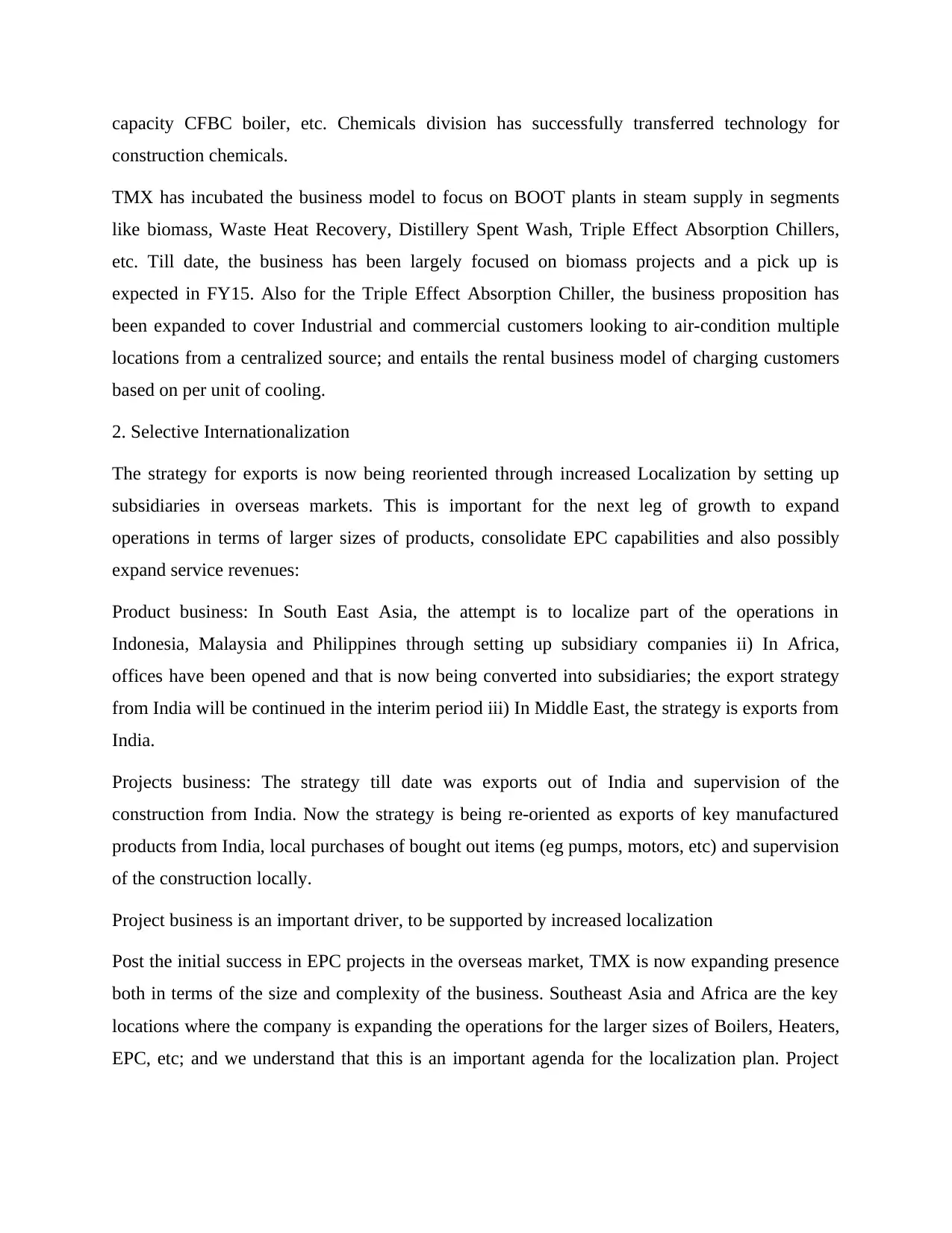
capacity CFBC boiler, etc. Chemicals division has successfully transferred technology for
construction chemicals.
TMX has incubated the business model to focus on BOOT plants in steam supply in segments
like biomass, Waste Heat Recovery, Distillery Spent Wash, Triple Effect Absorption Chillers,
etc. Till date, the business has been largely focused on biomass projects and a pick up is
expected in FY15. Also for the Triple Effect Absorption Chiller, the business proposition has
been expanded to cover Industrial and commercial customers looking to air-condition multiple
locations from a centralized source; and entails the rental business model of charging customers
based on per unit of cooling.
2. Selective Internationalization
The strategy for exports is now being reoriented through increased Localization by setting up
subsidiaries in overseas markets. This is important for the next leg of growth to expand
operations in terms of larger sizes of products, consolidate EPC capabilities and also possibly
expand service revenues:
Product business: In South East Asia, the attempt is to localize part of the operations in
Indonesia, Malaysia and Philippines through setting up subsidiary companies ii) In Africa,
offices have been opened and that is now being converted into subsidiaries; the export strategy
from India will be continued in the interim period iii) In Middle East, the strategy is exports from
India.
Projects business: The strategy till date was exports out of India and supervision of the
construction from India. Now the strategy is being re-oriented as exports of key manufactured
products from India, local purchases of bought out items (eg pumps, motors, etc) and supervision
of the construction locally.
Project business is an important driver, to be supported by increased localization
Post the initial success in EPC projects in the overseas market, TMX is now expanding presence
both in terms of the size and complexity of the business. Southeast Asia and Africa are the key
locations where the company is expanding the operations for the larger sizes of Boilers, Heaters,
EPC, etc; and we understand that this is an important agenda for the localization plan. Project
construction chemicals.
TMX has incubated the business model to focus on BOOT plants in steam supply in segments
like biomass, Waste Heat Recovery, Distillery Spent Wash, Triple Effect Absorption Chillers,
etc. Till date, the business has been largely focused on biomass projects and a pick up is
expected in FY15. Also for the Triple Effect Absorption Chiller, the business proposition has
been expanded to cover Industrial and commercial customers looking to air-condition multiple
locations from a centralized source; and entails the rental business model of charging customers
based on per unit of cooling.
2. Selective Internationalization
The strategy for exports is now being reoriented through increased Localization by setting up
subsidiaries in overseas markets. This is important for the next leg of growth to expand
operations in terms of larger sizes of products, consolidate EPC capabilities and also possibly
expand service revenues:
Product business: In South East Asia, the attempt is to localize part of the operations in
Indonesia, Malaysia and Philippines through setting up subsidiary companies ii) In Africa,
offices have been opened and that is now being converted into subsidiaries; the export strategy
from India will be continued in the interim period iii) In Middle East, the strategy is exports from
India.
Projects business: The strategy till date was exports out of India and supervision of the
construction from India. Now the strategy is being re-oriented as exports of key manufactured
products from India, local purchases of bought out items (eg pumps, motors, etc) and supervision
of the construction locally.
Project business is an important driver, to be supported by increased localization
Post the initial success in EPC projects in the overseas market, TMX is now expanding presence
both in terms of the size and complexity of the business. Southeast Asia and Africa are the key
locations where the company is expanding the operations for the larger sizes of Boilers, Heaters,
EPC, etc; and we understand that this is an important agenda for the localization plan. Project
Paraphrase This Document
Need a fresh take? Get an instant paraphrase of this document with our AI Paraphraser
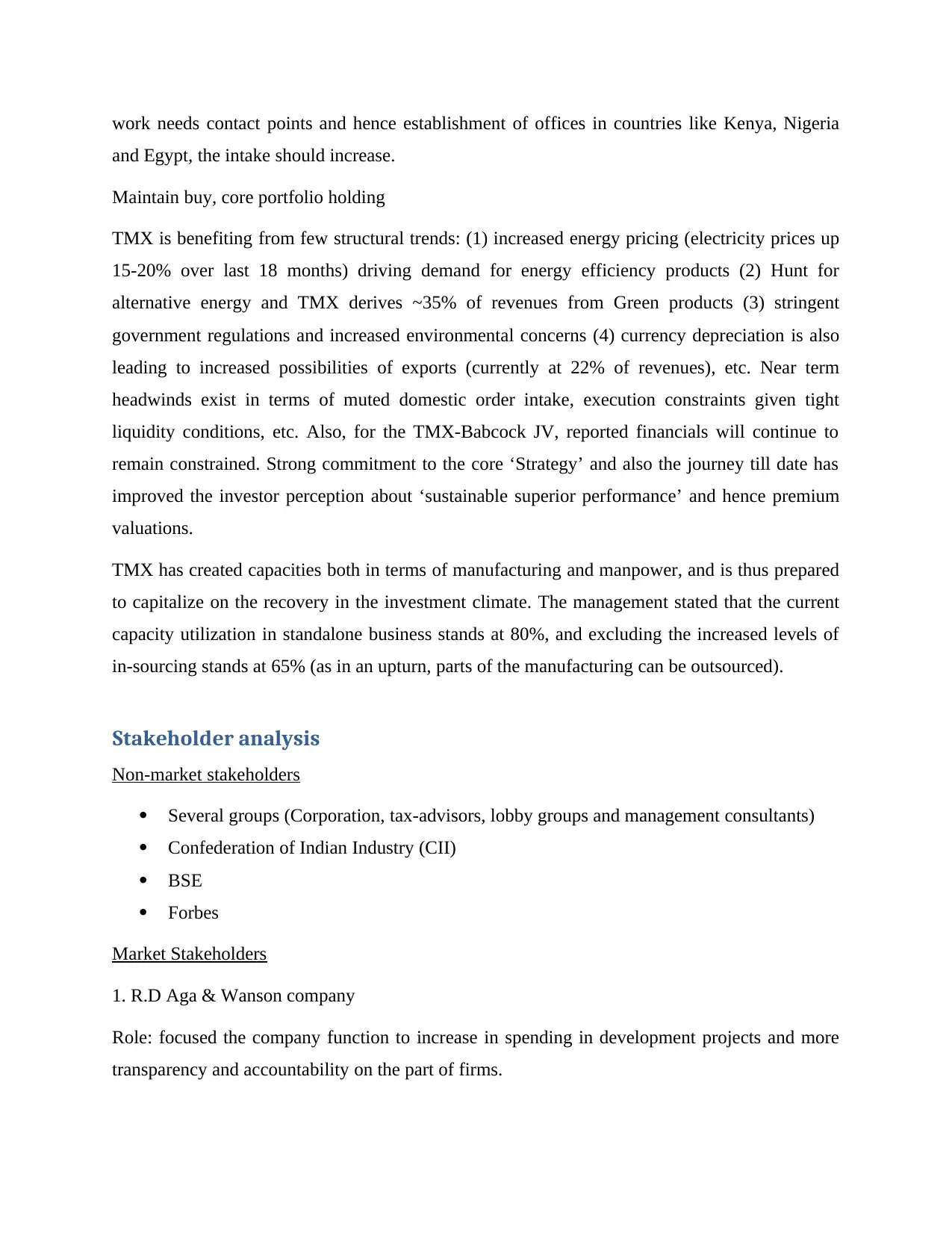
work needs contact points and hence establishment of offices in countries like Kenya, Nigeria
and Egypt, the intake should increase.
Maintain buy, core portfolio holding
TMX is benefiting from few structural trends: (1) increased energy pricing (electricity prices up
15-20% over last 18 months) driving demand for energy efficiency products (2) Hunt for
alternative energy and TMX derives ~35% of revenues from Green products (3) stringent
government regulations and increased environmental concerns (4) currency depreciation is also
leading to increased possibilities of exports (currently at 22% of revenues), etc. Near term
headwinds exist in terms of muted domestic order intake, execution constraints given tight
liquidity conditions, etc. Also, for the TMX-Babcock JV, reported financials will continue to
remain constrained. Strong commitment to the core ‘Strategy’ and also the journey till date has
improved the investor perception about ‘sustainable superior performance’ and hence premium
valuations.
TMX has created capacities both in terms of manufacturing and manpower, and is thus prepared
to capitalize on the recovery in the investment climate. The management stated that the current
capacity utilization in standalone business stands at 80%, and excluding the increased levels of
in-sourcing stands at 65% (as in an upturn, parts of the manufacturing can be outsourced).
Stakeholder analysis
Non-market stakeholders
Several groups (Corporation, tax-advisors, lobby groups and management consultants)
Confederation of Indian Industry (CII)
BSE
Forbes
Market Stakeholders
1. R.D Aga & Wanson company
Role: focused the company function to increase in spending in development projects and more
transparency and accountability on the part of firms.
and Egypt, the intake should increase.
Maintain buy, core portfolio holding
TMX is benefiting from few structural trends: (1) increased energy pricing (electricity prices up
15-20% over last 18 months) driving demand for energy efficiency products (2) Hunt for
alternative energy and TMX derives ~35% of revenues from Green products (3) stringent
government regulations and increased environmental concerns (4) currency depreciation is also
leading to increased possibilities of exports (currently at 22% of revenues), etc. Near term
headwinds exist in terms of muted domestic order intake, execution constraints given tight
liquidity conditions, etc. Also, for the TMX-Babcock JV, reported financials will continue to
remain constrained. Strong commitment to the core ‘Strategy’ and also the journey till date has
improved the investor perception about ‘sustainable superior performance’ and hence premium
valuations.
TMX has created capacities both in terms of manufacturing and manpower, and is thus prepared
to capitalize on the recovery in the investment climate. The management stated that the current
capacity utilization in standalone business stands at 80%, and excluding the increased levels of
in-sourcing stands at 65% (as in an upturn, parts of the manufacturing can be outsourced).
Stakeholder analysis
Non-market stakeholders
Several groups (Corporation, tax-advisors, lobby groups and management consultants)
Confederation of Indian Industry (CII)
BSE
Forbes
Market Stakeholders
1. R.D Aga & Wanson company
Role: focused the company function to increase in spending in development projects and more
transparency and accountability on the part of firms.
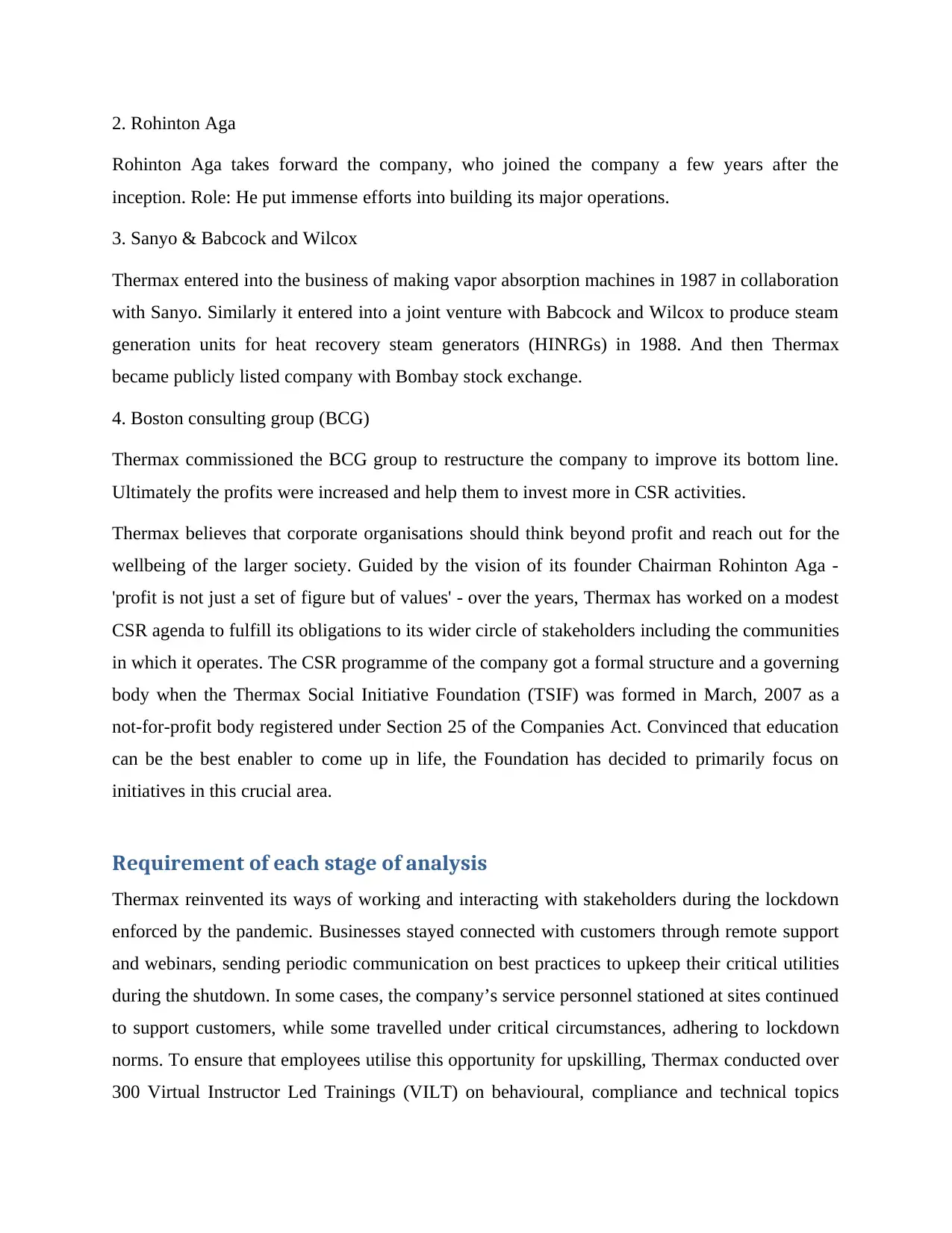
2. Rohinton Aga
Rohinton Aga takes forward the company, who joined the company a few years after the
inception. Role: He put immense efforts into building its major operations.
3. Sanyo & Babcock and Wilcox
Thermax entered into the business of making vapor absorption machines in 1987 in collaboration
with Sanyo. Similarly it entered into a joint venture with Babcock and Wilcox to produce steam
generation units for heat recovery steam generators (HINRGs) in 1988. And then Thermax
became publicly listed company with Bombay stock exchange.
4. Boston consulting group (BCG)
Thermax commissioned the BCG group to restructure the company to improve its bottom line.
Ultimately the profits were increased and help them to invest more in CSR activities.
Thermax believes that corporate organisations should think beyond profit and reach out for the
wellbeing of the larger society. Guided by the vision of its founder Chairman Rohinton Aga -
'profit is not just a set of figure but of values' - over the years, Thermax has worked on a modest
CSR agenda to fulfill its obligations to its wider circle of stakeholders including the communities
in which it operates. The CSR programme of the company got a formal structure and a governing
body when the Thermax Social Initiative Foundation (TSIF) was formed in March, 2007 as a
not-for-profit body registered under Section 25 of the Companies Act. Convinced that education
can be the best enabler to come up in life, the Foundation has decided to primarily focus on
initiatives in this crucial area.
Requirement of each stage of analysis
Thermax reinvented its ways of working and interacting with stakeholders during the lockdown
enforced by the pandemic. Businesses stayed connected with customers through remote support
and webinars, sending periodic communication on best practices to upkeep their critical utilities
during the shutdown. In some cases, the company’s service personnel stationed at sites continued
to support customers, while some travelled under critical circumstances, adhering to lockdown
norms. To ensure that employees utilise this opportunity for upskilling, Thermax conducted over
300 Virtual Instructor Led Trainings (VILT) on behavioural, compliance and technical topics
Rohinton Aga takes forward the company, who joined the company a few years after the
inception. Role: He put immense efforts into building its major operations.
3. Sanyo & Babcock and Wilcox
Thermax entered into the business of making vapor absorption machines in 1987 in collaboration
with Sanyo. Similarly it entered into a joint venture with Babcock and Wilcox to produce steam
generation units for heat recovery steam generators (HINRGs) in 1988. And then Thermax
became publicly listed company with Bombay stock exchange.
4. Boston consulting group (BCG)
Thermax commissioned the BCG group to restructure the company to improve its bottom line.
Ultimately the profits were increased and help them to invest more in CSR activities.
Thermax believes that corporate organisations should think beyond profit and reach out for the
wellbeing of the larger society. Guided by the vision of its founder Chairman Rohinton Aga -
'profit is not just a set of figure but of values' - over the years, Thermax has worked on a modest
CSR agenda to fulfill its obligations to its wider circle of stakeholders including the communities
in which it operates. The CSR programme of the company got a formal structure and a governing
body when the Thermax Social Initiative Foundation (TSIF) was formed in March, 2007 as a
not-for-profit body registered under Section 25 of the Companies Act. Convinced that education
can be the best enabler to come up in life, the Foundation has decided to primarily focus on
initiatives in this crucial area.
Requirement of each stage of analysis
Thermax reinvented its ways of working and interacting with stakeholders during the lockdown
enforced by the pandemic. Businesses stayed connected with customers through remote support
and webinars, sending periodic communication on best practices to upkeep their critical utilities
during the shutdown. In some cases, the company’s service personnel stationed at sites continued
to support customers, while some travelled under critical circumstances, adhering to lockdown
norms. To ensure that employees utilise this opportunity for upskilling, Thermax conducted over
300 Virtual Instructor Led Trainings (VILT) on behavioural, compliance and technical topics
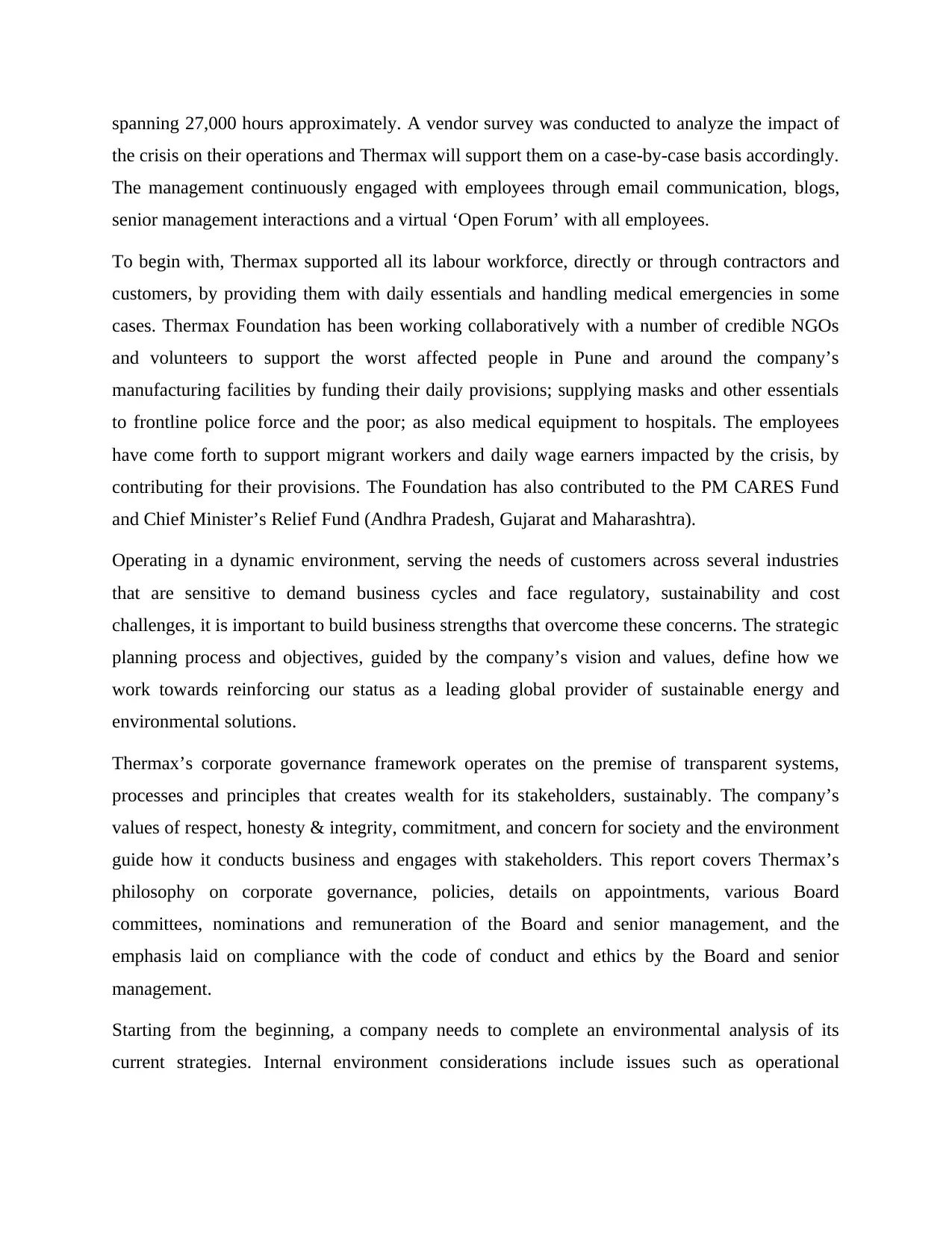
spanning 27,000 hours approximately. A vendor survey was conducted to analyze the impact of
the crisis on their operations and Thermax will support them on a case-by-case basis accordingly.
The management continuously engaged with employees through email communication, blogs,
senior management interactions and a virtual ‘Open Forum’ with all employees.
To begin with, Thermax supported all its labour workforce, directly or through contractors and
customers, by providing them with daily essentials and handling medical emergencies in some
cases. Thermax Foundation has been working collaboratively with a number of credible NGOs
and volunteers to support the worst affected people in Pune and around the company’s
manufacturing facilities by funding their daily provisions; supplying masks and other essentials
to frontline police force and the poor; as also medical equipment to hospitals. The employees
have come forth to support migrant workers and daily wage earners impacted by the crisis, by
contributing for their provisions. The Foundation has also contributed to the PM CARES Fund
and Chief Minister’s Relief Fund (Andhra Pradesh, Gujarat and Maharashtra).
Operating in a dynamic environment, serving the needs of customers across several industries
that are sensitive to demand business cycles and face regulatory, sustainability and cost
challenges, it is important to build business strengths that overcome these concerns. The strategic
planning process and objectives, guided by the company’s vision and values, define how we
work towards reinforcing our status as a leading global provider of sustainable energy and
environmental solutions.
Thermax’s corporate governance framework operates on the premise of transparent systems,
processes and principles that creates wealth for its stakeholders, sustainably. The company’s
values of respect, honesty & integrity, commitment, and concern for society and the environment
guide how it conducts business and engages with stakeholders. This report covers Thermax’s
philosophy on corporate governance, policies, details on appointments, various Board
committees, nominations and remuneration of the Board and senior management, and the
emphasis laid on compliance with the code of conduct and ethics by the Board and senior
management.
Starting from the beginning, a company needs to complete an environmental analysis of its
current strategies. Internal environment considerations include issues such as operational
the crisis on their operations and Thermax will support them on a case-by-case basis accordingly.
The management continuously engaged with employees through email communication, blogs,
senior management interactions and a virtual ‘Open Forum’ with all employees.
To begin with, Thermax supported all its labour workforce, directly or through contractors and
customers, by providing them with daily essentials and handling medical emergencies in some
cases. Thermax Foundation has been working collaboratively with a number of credible NGOs
and volunteers to support the worst affected people in Pune and around the company’s
manufacturing facilities by funding their daily provisions; supplying masks and other essentials
to frontline police force and the poor; as also medical equipment to hospitals. The employees
have come forth to support migrant workers and daily wage earners impacted by the crisis, by
contributing for their provisions. The Foundation has also contributed to the PM CARES Fund
and Chief Minister’s Relief Fund (Andhra Pradesh, Gujarat and Maharashtra).
Operating in a dynamic environment, serving the needs of customers across several industries
that are sensitive to demand business cycles and face regulatory, sustainability and cost
challenges, it is important to build business strengths that overcome these concerns. The strategic
planning process and objectives, guided by the company’s vision and values, define how we
work towards reinforcing our status as a leading global provider of sustainable energy and
environmental solutions.
Thermax’s corporate governance framework operates on the premise of transparent systems,
processes and principles that creates wealth for its stakeholders, sustainably. The company’s
values of respect, honesty & integrity, commitment, and concern for society and the environment
guide how it conducts business and engages with stakeholders. This report covers Thermax’s
philosophy on corporate governance, policies, details on appointments, various Board
committees, nominations and remuneration of the Board and senior management, and the
emphasis laid on compliance with the code of conduct and ethics by the Board and senior
management.
Starting from the beginning, a company needs to complete an environmental analysis of its
current strategies. Internal environment considerations include issues such as operational
Secure Best Marks with AI Grader
Need help grading? Try our AI Grader for instant feedback on your assignments.
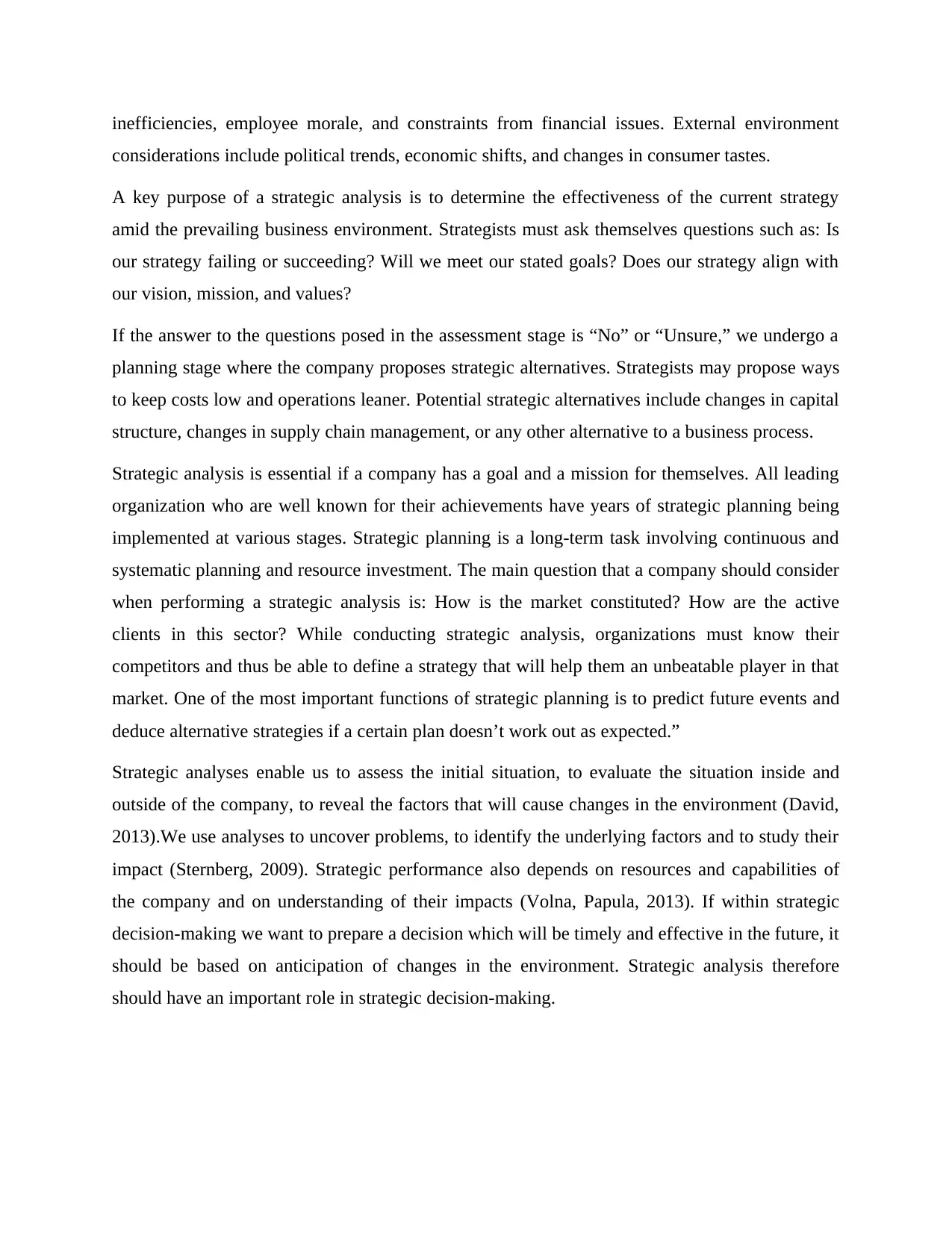
inefficiencies, employee morale, and constraints from financial issues. External environment
considerations include political trends, economic shifts, and changes in consumer tastes.
A key purpose of a strategic analysis is to determine the effectiveness of the current strategy
amid the prevailing business environment. Strategists must ask themselves questions such as: Is
our strategy failing or succeeding? Will we meet our stated goals? Does our strategy align with
our vision, mission, and values?
If the answer to the questions posed in the assessment stage is “No” or “Unsure,” we undergo a
planning stage where the company proposes strategic alternatives. Strategists may propose ways
to keep costs low and operations leaner. Potential strategic alternatives include changes in capital
structure, changes in supply chain management, or any other alternative to a business process.
Strategic analysis is essential if a company has a goal and a mission for themselves. All leading
organization who are well known for their achievements have years of strategic planning being
implemented at various stages. Strategic planning is a long-term task involving continuous and
systematic planning and resource investment. The main question that a company should consider
when performing a strategic analysis is: How is the market constituted? How are the active
clients in this sector? While conducting strategic analysis, organizations must know their
competitors and thus be able to define a strategy that will help them an unbeatable player in that
market. One of the most important functions of strategic planning is to predict future events and
deduce alternative strategies if a certain plan doesn’t work out as expected.”
Strategic analyses enable us to assess the initial situation, to evaluate the situation inside and
outside of the company, to reveal the factors that will cause changes in the environment (David,
2013).We use analyses to uncover problems, to identify the underlying factors and to study their
impact (Sternberg, 2009). Strategic performance also depends on resources and capabilities of
the company and on understanding of their impacts (Volna, Papula, 2013). If within strategic
decision-making we want to prepare a decision which will be timely and effective in the future, it
should be based on anticipation of changes in the environment. Strategic analysis therefore
should have an important role in strategic decision-making.
considerations include political trends, economic shifts, and changes in consumer tastes.
A key purpose of a strategic analysis is to determine the effectiveness of the current strategy
amid the prevailing business environment. Strategists must ask themselves questions such as: Is
our strategy failing or succeeding? Will we meet our stated goals? Does our strategy align with
our vision, mission, and values?
If the answer to the questions posed in the assessment stage is “No” or “Unsure,” we undergo a
planning stage where the company proposes strategic alternatives. Strategists may propose ways
to keep costs low and operations leaner. Potential strategic alternatives include changes in capital
structure, changes in supply chain management, or any other alternative to a business process.
Strategic analysis is essential if a company has a goal and a mission for themselves. All leading
organization who are well known for their achievements have years of strategic planning being
implemented at various stages. Strategic planning is a long-term task involving continuous and
systematic planning and resource investment. The main question that a company should consider
when performing a strategic analysis is: How is the market constituted? How are the active
clients in this sector? While conducting strategic analysis, organizations must know their
competitors and thus be able to define a strategy that will help them an unbeatable player in that
market. One of the most important functions of strategic planning is to predict future events and
deduce alternative strategies if a certain plan doesn’t work out as expected.”
Strategic analyses enable us to assess the initial situation, to evaluate the situation inside and
outside of the company, to reveal the factors that will cause changes in the environment (David,
2013).We use analyses to uncover problems, to identify the underlying factors and to study their
impact (Sternberg, 2009). Strategic performance also depends on resources and capabilities of
the company and on understanding of their impacts (Volna, Papula, 2013). If within strategic
decision-making we want to prepare a decision which will be timely and effective in the future, it
should be based on anticipation of changes in the environment. Strategic analysis therefore
should have an important role in strategic decision-making.
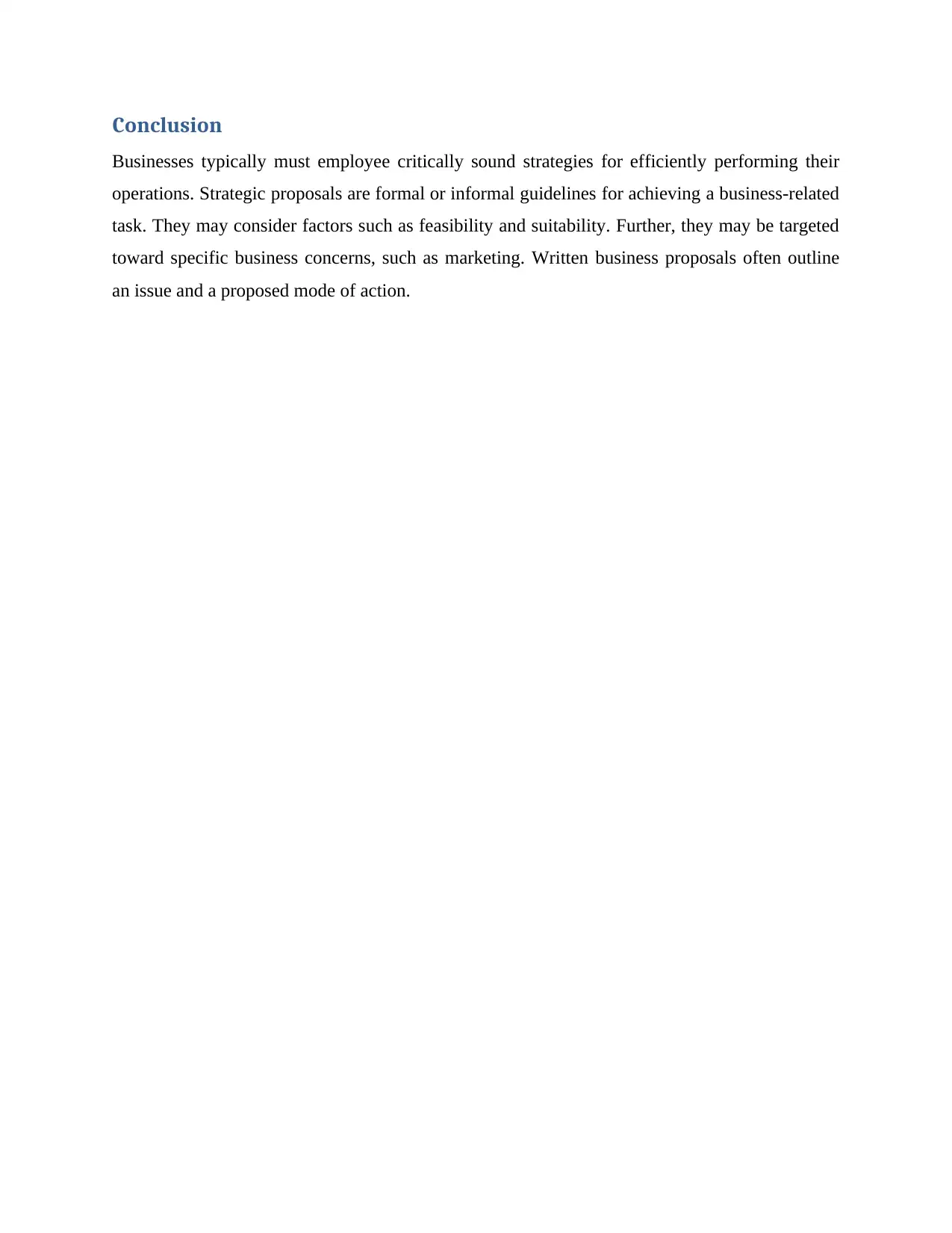
Conclusion
Businesses typically must employee critically sound strategies for efficiently performing their
operations. Strategic proposals are formal or informal guidelines for achieving a business-related
task. They may consider factors such as feasibility and suitability. Further, they may be targeted
toward specific business concerns, such as marketing. Written business proposals often outline
an issue and a proposed mode of action.
Businesses typically must employee critically sound strategies for efficiently performing their
operations. Strategic proposals are formal or informal guidelines for achieving a business-related
task. They may consider factors such as feasibility and suitability. Further, they may be targeted
toward specific business concerns, such as marketing. Written business proposals often outline
an issue and a proposed mode of action.
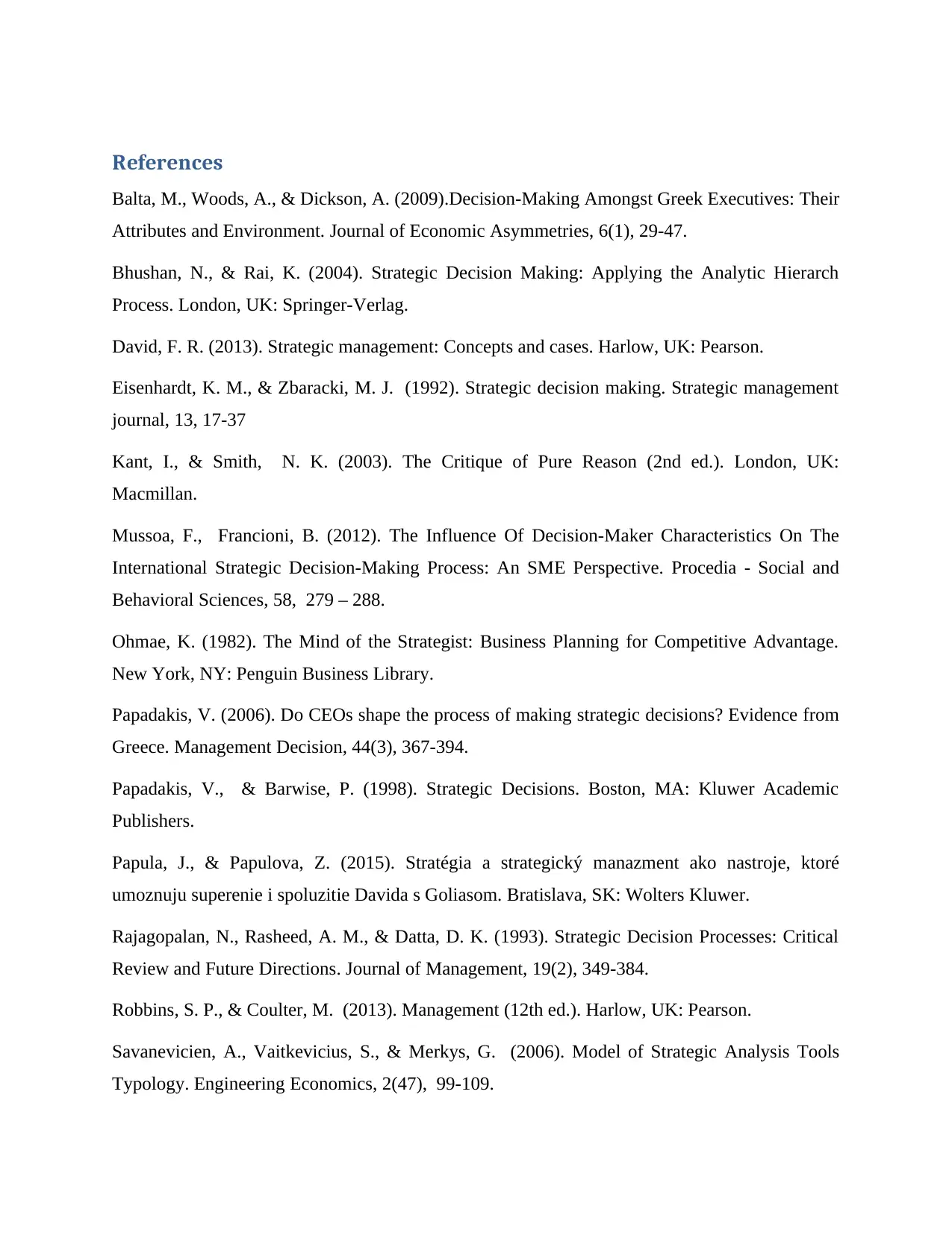
References
Balta, M., Woods, A., & Dickson, A. (2009).Decision-Making Amongst Greek Executives: Their
Attributes and Environment. Journal of Economic Asymmetries, 6(1), 29-47.
Bhushan, N., & Rai, K. (2004). Strategic Decision Making: Applying the Analytic Hierarch
Process. London, UK: Springer-Verlag.
David, F. R. (2013). Strategic management: Concepts and cases. Harlow, UK: Pearson.
Eisenhardt, K. M., & Zbaracki, M. J. (1992). Strategic decision making. Strategic management
journal, 13, 17-37
Kant, I., & Smith, N. K. (2003). The Critique of Pure Reason (2nd ed.). London, UK:
Macmillan.
Mussoa, F., Francioni, B. (2012). The Influence Of Decision-Maker Characteristics On The
International Strategic Decision-Making Process: An SME Perspective. Procedia - Social and
Behavioral Sciences, 58, 279 – 288.
Ohmae, K. (1982). The Mind of the Strategist: Business Planning for Competitive Advantage.
New York, NY: Penguin Business Library.
Papadakis, V. (2006). Do CEOs shape the process of making strategic decisions? Evidence from
Greece. Management Decision, 44(3), 367-394.
Papadakis, V., & Barwise, P. (1998). Strategic Decisions. Boston, MA: Kluwer Academic
Publishers.
Papula, J., & Papulova, Z. (2015). Stratégia a strategický manazment ako nastroje, ktoré
umoznuju superenie i spoluzitie Davida s Goliasom. Bratislava, SK: Wolters Kluwer.
Rajagopalan, N., Rasheed, A. M., & Datta, D. K. (1993). Strategic Decision Processes: Critical
Review and Future Directions. Journal of Management, 19(2), 349-384.
Robbins, S. P., & Coulter, M. (2013). Management (12th ed.). Harlow, UK: Pearson.
Savanevicien, A., Vaitkevicius, S., & Merkys, G. (2006). Model of Strategic Analysis Tools
Typology. Engineering Economics, 2(47), 99-109.
Balta, M., Woods, A., & Dickson, A. (2009).Decision-Making Amongst Greek Executives: Their
Attributes and Environment. Journal of Economic Asymmetries, 6(1), 29-47.
Bhushan, N., & Rai, K. (2004). Strategic Decision Making: Applying the Analytic Hierarch
Process. London, UK: Springer-Verlag.
David, F. R. (2013). Strategic management: Concepts and cases. Harlow, UK: Pearson.
Eisenhardt, K. M., & Zbaracki, M. J. (1992). Strategic decision making. Strategic management
journal, 13, 17-37
Kant, I., & Smith, N. K. (2003). The Critique of Pure Reason (2nd ed.). London, UK:
Macmillan.
Mussoa, F., Francioni, B. (2012). The Influence Of Decision-Maker Characteristics On The
International Strategic Decision-Making Process: An SME Perspective. Procedia - Social and
Behavioral Sciences, 58, 279 – 288.
Ohmae, K. (1982). The Mind of the Strategist: Business Planning for Competitive Advantage.
New York, NY: Penguin Business Library.
Papadakis, V. (2006). Do CEOs shape the process of making strategic decisions? Evidence from
Greece. Management Decision, 44(3), 367-394.
Papadakis, V., & Barwise, P. (1998). Strategic Decisions. Boston, MA: Kluwer Academic
Publishers.
Papula, J., & Papulova, Z. (2015). Stratégia a strategický manazment ako nastroje, ktoré
umoznuju superenie i spoluzitie Davida s Goliasom. Bratislava, SK: Wolters Kluwer.
Rajagopalan, N., Rasheed, A. M., & Datta, D. K. (1993). Strategic Decision Processes: Critical
Review and Future Directions. Journal of Management, 19(2), 349-384.
Robbins, S. P., & Coulter, M. (2013). Management (12th ed.). Harlow, UK: Pearson.
Savanevicien, A., Vaitkevicius, S., & Merkys, G. (2006). Model of Strategic Analysis Tools
Typology. Engineering Economics, 2(47), 99-109.
Paraphrase This Document
Need a fresh take? Get an instant paraphrase of this document with our AI Paraphraser
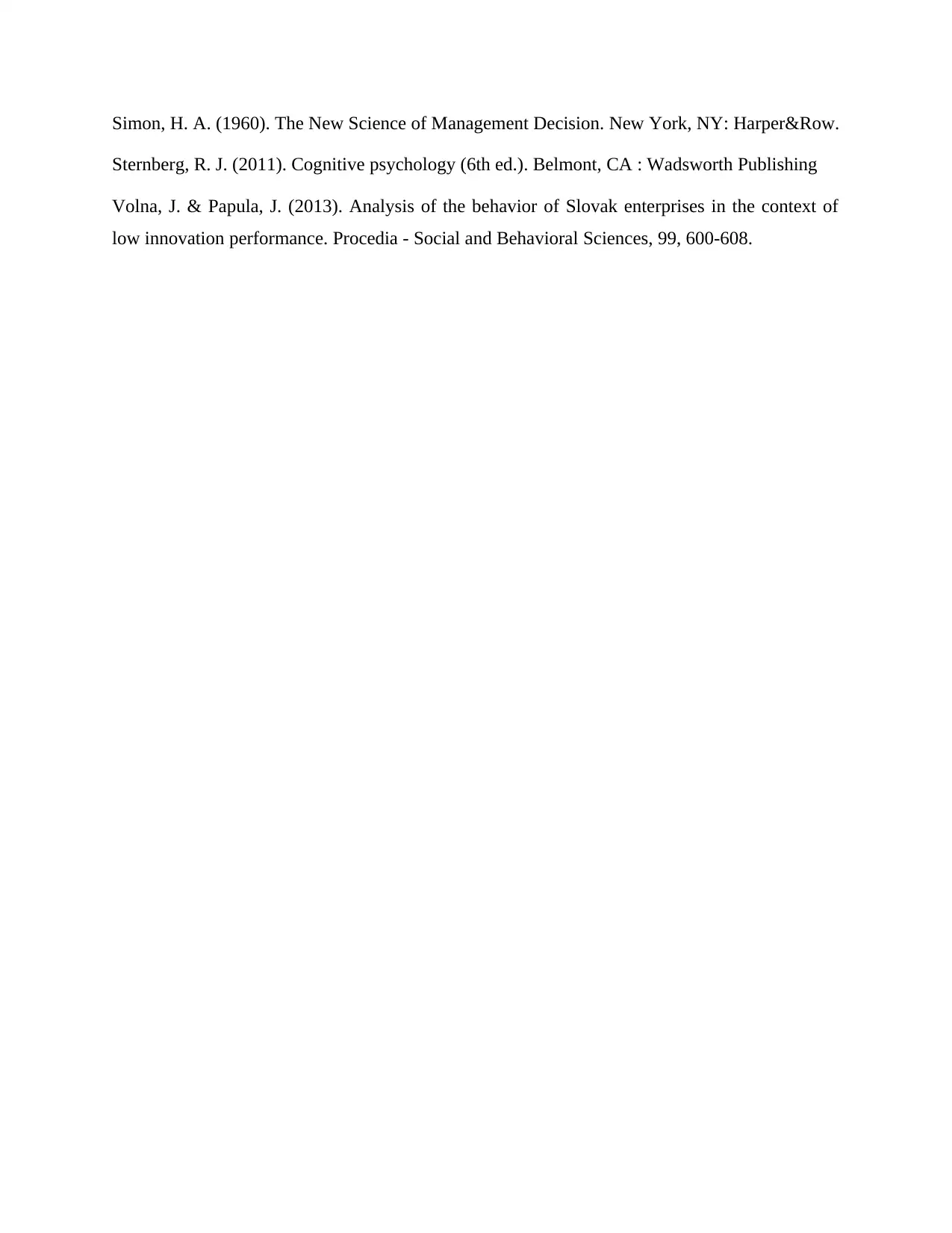
Simon, H. A. (1960). The New Science of Management Decision. New York, NY: Harper&Row.
Sternberg, R. J. (2011). Cognitive psychology (6th ed.). Belmont, CA : Wadsworth Publishing
Volna, J. & Papula, J. (2013). Analysis of the behavior of Slovak enterprises in the context of
low innovation performance. Procedia - Social and Behavioral Sciences, 99, 600-608.
Sternberg, R. J. (2011). Cognitive psychology (6th ed.). Belmont, CA : Wadsworth Publishing
Volna, J. & Papula, J. (2013). Analysis of the behavior of Slovak enterprises in the context of
low innovation performance. Procedia - Social and Behavioral Sciences, 99, 600-608.
1 out of 14
Your All-in-One AI-Powered Toolkit for Academic Success.
+13062052269
info@desklib.com
Available 24*7 on WhatsApp / Email
![[object Object]](/_next/static/media/star-bottom.7253800d.svg)
Unlock your academic potential
© 2024 | Zucol Services PVT LTD | All rights reserved.

